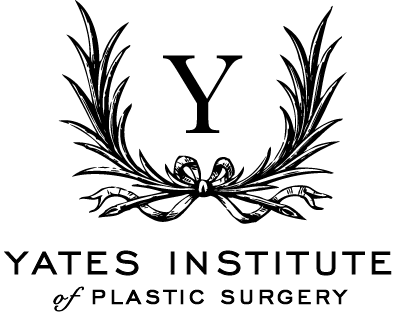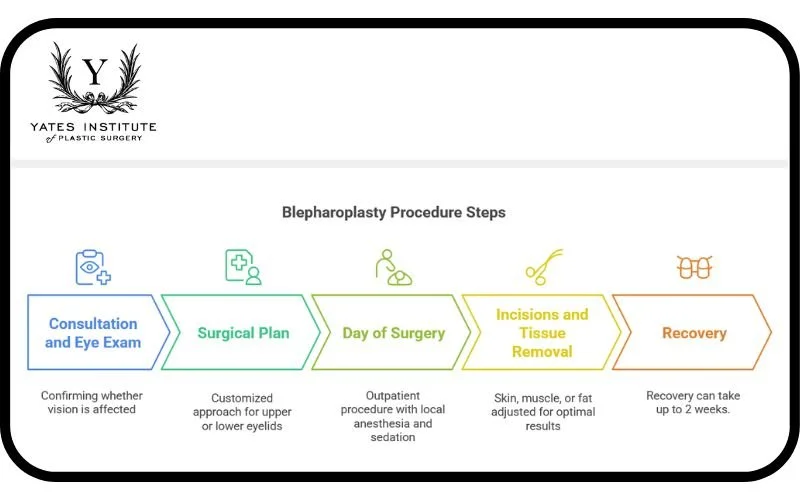Can Blepharoplasty Improve Your Vision?
Blepharoplasty and Vision: Benefits, Risks, and What to Expect
Have you ever found yourself struggling to keep your eyes fully open by the end of the day? Maybe you catch yourself raising your eyebrows or tilting your head back just to get a clearer view of what’s in front of you. Or perhaps you’ve noticed that reading for long periods, working on a screen, or even driving at night feels more difficult than it used to. If this sounds familiar, your drooping eyelids may be affecting your vision—and you’re not alone.
Many people assume that blepharoplasty, or eyelid surgery, is purely cosmetic. And while it’s true that this procedure can give the eyes a more refreshed, youthful look, it can also serve a medical purpose. When excess eyelid skin sags low enough to interfere with vision, surgery can remove the obstruction, improve clarity, and even reduce eye strain. In some cases, it’s not just about looking better—it’s about seeing better.
If you’ve been wondering whether blepharoplasty can actually help you see more clearly, let’s break it down. We’ll explore how eyelids affect vision, when surgery is considered medically necessary, and how you can determine if it’s the right choice for you.
The Hidden Impact of Droopy Eyelids on Vision
Why Do Eyelids Sag?
Eyelid sagging is a natural part of aging, but for some people, it happens earlier or more severely than expected. There are a few key reasons why this happens:
Loss of Skin Elasticity: Over time, the skin produces less collagen and elastin, causing it to become thinner and more prone to sagging.
Weakened Eyelid Muscles: The levator muscle, which lifts the upper eyelid, can weaken with age or from repetitive strain.
Fat Redistribution: Fat pockets around the eyes may shift downward, leading to puffiness and heaviness.
Genetics: Some people are simply born with naturally heavier eyelids or develop sagging earlier due to their genetic makeup.
Medical Conditions: Certain conditions like ptosis (a muscle-related eyelid droop) or dermatochalasis (excess skin on the eyelid) can cause significant obstruction of vision.
How Can Drooping Eyelids Affect Vision?
You might not immediately associate sagging eyelids with vision problems, but the effects can be more serious than you think:
Blocked Peripheral Vision: The most common issue is a reduction in your upper field of vision. If your eyelids droop far enough, they can literally block part of what you see.
Eye Strain and Fatigue: Many people unconsciously compensate for droopy eyelids by raising their eyebrows, which can lead to forehead strain, headaches, and even chronic tension.
Blurred Vision and Glare Sensitivity: Excess skin and fat can weigh down the eyelids, making it harder to keep your eyes fully open, leading to blurred or obstructed vision.
Difficulty with Daily Activities: Tasks like reading, using a computer, driving, and even recognizing faces may become frustrating.
For some, these issues develop gradually and go unnoticed until they start to impact daily life. If any of these symptoms sound familiar, it may be time to explore whether blepharoplasty could improve your vision.
What is Functional Blepharoplasty?
Blepharoplasty is often thought of as a cosmetic procedure, but when it’s performed for medical reasons, it’s classified as a functional surgery. The difference comes down to why you need the procedure:
Cosmetic blepharoplasty is done to improve appearance, reducing puffiness, fine lines, or a tired look. It doesn’t typically impact vision.
Functional blepharoplasty is recommended when excess eyelid skin interferes with vision, affecting activities like reading and driving. In these cases, it’s considered a medically necessary procedure rather than an elective one.
When Does Insurance Cover Blepharoplasty?
If your eyelid drooping is severe enough to affect your vision, insurance may cover the procedure. However, there are certain requirements:
Documented visual impairment: You’ll likely need to undergo a visual field test, which measures how much of your peripheral vision is blocked by your eyelids.
Medical necessity: If it’s determined that the drooping is causing functional problems—rather than just being a cosmetic concern—insurance may approve the surgery.
Formal evaluation: A formal assessment is typically required to confirm the need for functional blepharoplasty.
How Functional Blepharoplasty Improves Vision
If you qualify for functional blepharoplasty, the improvements can be significant:
✔ Wider Visual Field: Removing excess skin eliminates obstructions, restoring full peripheral vision.
✔ Less Eye Strain: Without heavy eyelids dragging down, your forehead muscles can relax, reducing strain and headaches.
✔ Better Light Exposure: More light enters the eyes, which can improve sharpness and clarity of vision.
✔ Easier Daily Activities: Tasks like reading, driving, and computer work become more comfortable.
For those dealing with chronic eye fatigue or obstructed vision, the difference after surgery is often immediate and life-changing.
Is Blepharoplasty Right for You? (Self-Assessment Quiz)
Before scheduling a consultation, you might be wondering if your symptoms are severe enough to qualify for surgery. While a plastic surgeon’s assessment is necessary for an official diagnosis, you can do a quick self-check with the following questions:
✔ Do you struggle with reading small print or using screens for long periods?
✔ Do your eyelids feel heavy by the end of the day, making it harder to keep your eyes open?
✔ Do you frequently raise your eyebrows or tilt your head back to see more clearly?
✔ Have you noticed a reduction in your peripheral vision, especially in the upper field?
✔ Do you experience frequent eye fatigue, strain, or tension headaches?
✔ Has anyone mentioned that your eyes look tired, droopy, or partially closed?
If you answered "yes" to several of these, it may be time to consider blepharoplasty. A professional evaluation can determine whether your eyelids are affecting your vision and if surgery is the right step.
What to Expect from the Procedure
Before moving forward with blepharoplasty, the first step is a comprehensive consultation and eye exam to determine whether your vision is significantly affected by drooping eyelids. During this visit, your surgeon will assess your upper and lower eyelids, discuss your symptoms, and possibly conduct a visual field test to measure how much of your peripheral vision is obstructed. Based on the findings, a personalized surgical plan is created to address your specific concerns. Some patients require only upper eyelid correction, while others may benefit from both upper and lower blepharoplasty. The goal is to not only restore clear vision but also create a natural, well-balanced look that complements your facial structure.
On the day of surgery, the procedure is typically performed as an outpatient treatment under local anesthesia with sedation, meaning you’ll be awake but comfortable. Small, precise incisions are made along the natural creases of the eyelids to minimize visible scarring. Excess skin, fat, or muscle is removed or repositioned to lift and reshape the eyelid for improved function and aesthetics. Once adjustments are made, the incisions are carefully closed with fine sutures, ensuring a smooth healing process. Since the cuts are hidden in natural folds, any scarring is usually discreet. The entire procedure usually takes one to two hours, and after a short recovery period, you’ll be able to go home the same day to begin the healing process.
Risks and Long-Term Results of Blepharoplasty
While blepharoplasty is a safe and effective procedure, it’s important to be aware of potential side effects. Some patients experience temporary dry eyes, irritation, or sensitivity to light during the initial healing phase. This usually resolves within a few weeks as the eyelids adjust to their new shape. Mild swelling and bruising are also common but typically subside within the first couple of weeks. In rare cases, overcorrection can occur, where too much skin is removed, making it difficult to fully close the eyes. This can lead to dryness and discomfort if not properly managed. That’s why having a thorough consultation before surgery is essential—setting realistic expectations and ensuring the right approach is taken to achieve both functional and aesthetic improvements.
The results of blepharoplasty can last 10 to 15 years, sometimes even longer, depending on your skin’s natural aging process, lifestyle habits, and genetics. While the procedure cannot stop aging, it can significantly delay the effects of sagging eyelids. For most patients, vision improvements are long-lasting, making daily activities like reading, driving, and working on screens much more comfortable. Protecting your skin from the sun and maintaining good eye health can help extend the benefits of the surgery.
Final Words
Blepharoplasty isn’t just about aesthetics—it can restore clear vision, reduce eye strain, and improve daily comfort. If sagging eyelids are making reading, driving, or screen time more difficult, this procedure could be a life-changing solution. With long-lasting results and a smooth recovery, it’s a safe and effective way to enhance both function and appearance. Stop letting droopy eyelids blur your vision—schedule your consultation today! Take the first step toward better sight and refreshed eyes by booking an appointment at the Yates Institute of Plastic Surgery in Fort Lauderdale.
FAQs about Blepharoplasty and Vision
Can blepharoplasty help with chronic headaches or eye fatigue?
Yes, for some patients, drooping eyelids cause constant forehead muscle strain from lifting the eyebrows to see clearly. This can lead to tension headaches and eye fatigue. By removing excess skin and reducing the need to overcompensate, blepharoplasty can relieve this strain and reduce headache frequency.
Will I need additional procedures after blepharoplasty to maintain results?
While blepharoplasty provides long-lasting improvements, aging continues. Some patients may choose non-surgical treatments like Botox or laser resurfacing later on to maintain a refreshed look, but additional eyelid surgery is rarely needed for functional improvements.
How soon after surgery can I return to work and daily activities?
Most patients feel comfortable returning to non-strenuous activities within 7 to 10 days. If your job involves heavy lifting or prolonged screen time, you may need a bit longer before resuming full duties. Swelling and bruising improve significantly after the first week.
Can blepharoplasty correct asymmetrical eyelids?
Yes, if one eyelid sags more than the other, surgery can create a more balanced, symmetrical appearance, while also addressing vision concerns if drooping affects your sight.
Will I need glasses or contacts after blepharoplasty?
Blepharoplasty does not change your eye prescription, but some patients report improved comfort wearing glasses or contacts after surgery since their eyelids no longer press down on their frames or lenses.
Further Reading about Blepharoplasty with Dr. Essie Yates
Read more about When Should You Consider Eyelid Surgery? - Signs to Look For
Read more about Say Goodbye to Tired Eyes
Read more about Blepharoplasty vs. Brow Lift
Read more about Timeline for Recovery after Blepharoplasty
Read more about Causes and Solutions for Hooded Eyes




